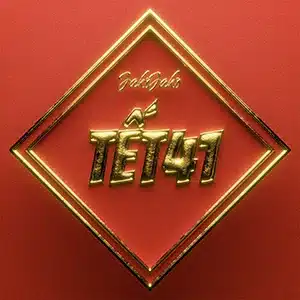
JakoJako’s Tết 41 is a truly artful work of modular synthesizers, compelling even at its most sedate and brilliant when it opens further.
 Tết 41 JakoJako Mute 25 April 2025
Tết 41 JakoJako Mute 25 April 2025
Modular synthesist and composer JakoJako’s new album Tết 41 begins looking outward. Opening track “Xin chào” (Vietnamese for “hello”) is a compilation of field recordings that convey a gently jubilant feeling: an ensemble of lively percussion plays in the distance, bamboo flute and zither sway to a much slower rhythm somewhere to the right, and voices of all ages and pitches fill the sonic ground. It’s a warm pastiche of the sounds of Tết, the Vietnamese Lunar New Year, which marks the beginning of spring. It seems to promise bigger and more boisterous things ahead, and then, softly, it dissolves.
The journey JakoJako (Berlin-based artist Sibel Koçer) takes us on, between the first field recordings and the voices and traffic sounds that make up the closing track, “Cảm ơn” (“thank you”), feels primarily internal. That’s not to say that it’s a slow ride; Tết 41 has many moments of exuberance. However, her minimal approach to the instrumentation on each track fully immerses us in her process as she explores deeply rooted personal connections to the festivities around her. It’s a substantial perspective, and listening feels like an act of both intimacy and expansion.

Tết 41 by JakoJako
Aiding this inward-outward motion is the album’s sheer conceptual simplicity. At its essence, everything between intro and outro is Koçer as soloist, expertly layering synthesizer parts to evoke aspects of Vietnam during Tết. Each track title names its focus plainly, offering a concrete object around which to comprehend the soundscapes at hand. The quick beats of “Kumquat” land in tones as bright and round as the fruit itself. “Lì xì”, named for the red envelopes of lucky money given out during the new year, glimmers, resonant with metallic joy.
Two tracks pay direct homage to the city of Đà Nẵng. “Đà Nẵng” opens with tanpura-like drones scattered with sonic bursts that add texture to what feels like a gradual twilight; “Dragon Bridge” follows, tracing the golden curves of the ornate structure from tail to fire-breathing head and back again with a looping feeling of awe.
A sense of weightlessness comes through in the vaporous foundation of “Chim sẻ”, named for the sparrow; a sense of play in the pixelated staccato melody of “Gió”, meaning “wind”. On the aforementioned final track “Cảm ơn”, Koçer runs a legato current of her instrument through the local ambience, bringing together her creative expressions and the sounds around her. Her presence is elated.
On Tết 41, we witness JakoJako as she witnesses the most spectacular annual celebration in Vietnam. Her synthesizers are her voice, and in this musical mode, she depicts vivid scenes, often with almost meditative reverence. She is the mediator, the storyteller, the bridge between audience and setting, and so the tales we receive are characterized by her often sparse and spacious aesthetic. Koçer finds peace amid the revelry, zooming in and out and taking in every element, big or small, that catches her attention. Tết 41 is a truly artful work of modular synthesizers, compelling even at its most sedate and brilliant when it opens further.


